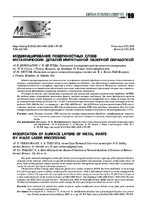| dc.contributor.author | Верещагин, М. Н. | |
| dc.contributor.author | Целуева, С. Н. | |
| dc.contributor.author | Целуев, М. Ю. | |
| dc.coverage.spatial | Минск | ru |
| dc.date.accessioned | 2020-04-03T11:34:20Z | |
| dc.date.available | 2020-04-03T11:34:20Z | |
| dc.date.issued | 2020 | |
| dc.identifier.citation | Верещагин, М. Н. Модифицирование поверхностных слоев металлических деталей импульсной лазерной обработкой = Modification of surface layers of metal parts by pulse laser processing / М. Н. Верещагин, С. Н. Целуева, М. Ю. Целуев // Литье и металлургия. – 2020. – № 1. – С. 99-109. | ru |
| dc.identifier.uri | https://rep.bntu.by/handle/data/70362 | |
| dc.description.abstract | Одной из распространенных технологических схем процесса лазерной обработки металлических деталей является лазерное «глазурование» нанесенного тонкого слоя порошка на подложку, что обеспечивает возможность получения микрокристаллических и аморфных структур в тонких поверхностных слоях деталей. Импульсное плавление малых объемов металла на поверхности обеспечивает получение гомогенных жидкостей (расплавов), которые после кристаллизации могут фиксировать структуру жидкости с уникальными свойствами. Установлено наличие трех диапазонов энерговклада при импульсной лазерной поверхностной обработке (ИЛПО). На среднем уровне энерговклада происходит процесс лазерной наплавки материала, при этом фиксируется высокая адгезионная связь между покрытием и заготовкой. Наплавка покрытия из аморфизируемого сплава на основе железа на металлическую основу из сталей Ст3, 45 20Х13 начинается при плотности лазерного излучения на поверхности обработки 1800–2000 Вт/мм2, а легирование – при 3500–4000 Вт/мм2. При ИЛПО зона лазерного воздействия (ЗЛВ) имеет слоистое строение: зона оплавления (ЗО), зона термического влияния (ЗТВ), зона исходного материала. Для получения аморфно-кристаллической структуры покрытия частота импульсов лазерного излучения не должна превышать 3–8 Гц. | ru |
| dc.language.iso | ru | ru |
| dc.publisher | БНТУ | ru |
| dc.title | Модифицирование поверхностных слоев металлических деталей импульсной лазерной обработкой | ru |
| dc.title.alternative | Modification of surface layers of metal parts by pulse laser processing | ru |
| dc.type | Article | ru |
| dc.identifier.doi | 10.21122/1683-6065-2020-1-99-109 | |
| local.description.annotation | One of the common technological schemes for the laser processing of metal parts is laser «glazing» of the deposited thin layer of powder on the substrate, which makes it possible to obtain microcrystalline and amorphous structures in thin surface layers of parts. Pulse melting of small volumes of metal on the surface provides homogeneous liquids (melts), which, after crystallization, can fix the structure of a liquid with unique properties. The presence of three energy input ranges for pulsed laser surface treatment (ILPO) has been established. At an average level of energy input, a process of laser surfacing of the material occurs, while a high adhesive bond between the coating and the workpiece is fixed. The deposition of an amorphized iron-based alloy coating on a metal base of St3, 45 20X13 steels begins at a laser radiation density on the treatment surface of 1800–2000 W/mm2, and alloying at 3500–4000 W/mm2. With ILPO, the laser exposure zone (ZLV) has a layered structure – the fusion zone (ZO), the heat-affected zone (HAZ), and the source material zone. To obtain an amorphous-crystalline structure of the coating, the laser pulse frequency should not exceed 3–8 Hz. | ru |

